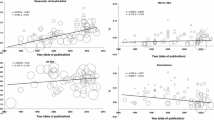Abstract
The aim of this study was to assess the nocebo effect in all randomised controlled trials (RCTs) exploring the effect of antiepileptic drugs (AEDs) in the clinical conditions in which these compounds have been studied with the exception of epilepsy. We searched for all double-blind, placebo-controlled trials performed in adult patients, testing AEDs in any clinical condition except epilepsy. The following data were extracted from the placebo arms: the number of randomized patients, the number of patients withdrawing because of adverse effects (AEs), and the number of patients with 11 predefined AEs (dizziness, ataxia/coordination abnormal, diplopia, somnolence, fatigue, headache, memory impairment, tremor, abnormal thinking, anxiety and depression). Outcome measures were the percentages of patients whithdrawing due to AEs and reporting the selected AEs. RCTs included in the analysis were grouped in six main categories of clinical conditions (pain, movement disorders, psychiatric disorders, substance abuse, obesity and binge eating disorders, and miscellanea). Proportions of patients with 95 % confidence intervals (CIs) have been calculated for all reported outcome measures. Thirteen AEDs were studied and the total number of selected RCTs was 157. Significant percentages of placebo-treated patients withdrawing due to AEs and with specific AEs were observed in several cases. Significant differences emerged across different conditions. Comparisons with results of a previous meta-analysis on all RCTs in patients with drug-resistant epilepsies showed that ataxia, diplopia and fatigue were significantly more frequent, and patients withdrawing were significantly less frequent, in placebo-treated epileptic patients. Significant differences have been identified in the AEDs-induced nocebo effect across different conditions. Placebo-treated epilepsy patients have significantly more frequent neurological AEs.


Similar content being viewed by others
References
Sullivan R, Behncke I, Purushotham A (2010) Why do we love medicines so much? An evolutionary perspective on the human love of pills, potions and placebo. EMBO Rep 11:572–578
Murray D, Stoessl AJ (2013) Mechanisms and therapeutic implications of the placebo effect in neurological and psychiatric conditions. Pharmacol Ther 140:306–318
Finniss DG, Kaptchuk TJ, Miller F, Benedetti F (2010) Placebo effects: biological, clinical and ethical advances. Lancet 375:686–695
Häuser W, Hansen E, Enck P (2012) Nocebo phenomena in medicine: their relevance in everyday clinical practice. Dtsch Arztebl Int 109:459–465
Annoni M (2013) Highlights from the 2013 Science of Placebo thematic workshop. eCancer 7:346
Zaccara G, Giovannelli F, Schmidt D (2015) Placebo and nocebo responses in drug trials of epilepsy. Epilepsy Behav 43:128–134
Amanzio M, Corazzini LL, Vase L, Benedetti F (2009) A systematic review of adverse events in placebo groups of anti-migraine clinical trials. Pain 146:261–269
Zaccara G, Giovannelli F, Cincotta M, Loiacono G, Verrotti A (2015) Adverse events of placebo-treated, drug-resistant, focal epileptic patients in randomized controlled trials: a systematic review. J Neurol 262:501–515
Moher D, Liberati A, Tetzlaff J, Altman DG (2009) Preferred reporting items for systematic reviews and meta-analyses: the PRISMA statement. PLoS Med 6:e1000097
Higgins JPT, Altman DG. (2008) Chapter 8: assessing risk of bias in included studies. Cochrane handbook for systematic reviews of interventions version 5.0.1 [updated September 2008]. Available at website: http://www.cochrane-handbook.org/. Accessed October 2015
Wallace BC, Schmid CH, Lau J, Trikalinos TA (2009) Meta-Analyst: software for meta-analysis of binary, continuous and diagnostic data. BMC Med Res Methodol 9:80
Enck P, Klosterhalfen S, Weimer K et al (2011) The placebo response in clinical trials: more questions than answers. Philos Trans R Soc 366:1889–1895
Mitsikostas DD, Mantonakis L, Chalarakis N (2014) Nocebo in clinical trials for depression: a meta-analysis. Psychiatry Res 215:82–86
Stathis P, Smpiliris M, Konitsiotis S, Mitsikostas DD (2013) Nocebo as a potential confounding factor in clinical trials for Parkinson’s disease treatment: a meta-analysis. Eur J Neurol 20:527–533
Wang XQ, Lang SY, He MW, Zhang X, Zhu F, Dai W, Shi XB, Wan M, Ma YF, Chen YN, Yu SY (2014) High prevalence of headaches in patients with epilepsy. J Headache Pain 15:70
Hossain KJ, Nandi AK, Karim MR, Haque MM, Kamal MM (2012) Pattern of mental illness on substance abusers. Mymensingh Med J 21:251–258
Aichmüller C, Soyka M (2015) Fatigue in substance abuse disorders. Rev Med Suisse 11:927–930
Perucca P, Gilliam FG (2012) Adverse effects of antiepileptic drugs. Lancet Neurol 11:792–802
Baker GA, Camfield C, Camfield P, Cramer JA, Elger CE, Johnson AL, Martins da Silva A, Meinardi H, Munari C, Perucca E, Thorbeke R (1998) Commission on outcome measurement in epilepsy, 1994–1997: final report. Epilepsia 39:213–231
Sedgwick P, Greenwood N (2015) Understanding the Hawthorne effect. BMJ 351:h4672
Perucca E, Kwan P (2005) Overtreatment in epilepsy: how it occurs and how it can be avoided. CNS Drugs 19:897–908
Gilliam FG, Fessler AJ, Baker G, Vahle V, Carter J, Attarian H (2004) Systematic screening allows reduction of adverse antiepileptic drug effects: a randomized trial. Neurology 62:23–27
Author information
Authors and Affiliations
Corresponding author
Ethics declarations
Ethical publication statement
We confirm that we have read the Journal’s position on issues involved in ethical publication and affirm that this report is consistent with those guidelines.
Funding
The authors received no funding for this study. FG is supported by a grant by “Ente Cassa di Risparmio di Firenze”.
Conflicts of interest
GZ has received speaker’s or consultancy fees from EISAI, Jansen-Cilag, Sanofi-Aventis, and UCB Pharma. FG FSG and SG report no disclosures. VF is a former employee of Eisai s.r.l., Italy.
Electronic supplementary material
Below is the link to the electronic supplementary material.
Rights and permissions
About this article
Cite this article
Zaccara, G., Giovannelli, F., Giorgi, F.S. et al. Analysis of nocebo effects of antiepileptic drugs across different conditions. J Neurol 263, 1274–1279 (2016). https://doi.org/10.1007/s00415-015-8018-7
Received:
Revised:
Accepted:
Published:
Issue Date:
DOI: https://doi.org/10.1007/s00415-015-8018-7




